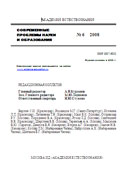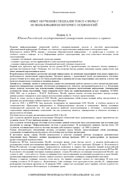PDF-версия статьи


|
The use of ICT in the development of educational situations arises with the advent of the computer, its use, both in everyday life and in the educational process as part of the modernization of Kazakhstan´s education.
Systematization of scientific and methodological approaches that determine the essence of the formation of ICT competence of pedagogical workers of a general education organization allowed to systematize and substantiate methodological approaches to managing the formation of ICT competence of pedagogical workers, defining the essence and discovering the new content of this category. The results of the study are: summarized and proposed methodological basis for determining the volume, content and level of development of professional competencies.
Competence in ICT and related standards are designed to help universities and teachers in organizing the educational process, taking into account their needs and level of ICT implementation.
It is assumed that the proposed route of study will allow teachers:
- recognize their expectations from the point of view of pedagogical
measurement and ICT implementation in their teaching practice and professional work.
- identify your training needs in terms of ICT competence and related standards.
- use of the training route to determine the training route in order to increase the level of ICT implementation and relevant professional skills.
The goal of this article is for universities and the teaching team to determine the level of ICT implementation in their educational practice, using assessment tools based on ICT competency standards from the pedagogical dimension.
After the level of acceptance, competencies and categories have been established, it is vital to find a concrete way to evaluate the work of teachers. In addition to classifying teachers at a certain level, the standards allow defining ICT introduction profiles based on their use of technology in specific practice [1].
Levels are a tool for analyzing how teachers at different levels of education include ICT in teaching. It is a universal tool because it can be used in many ways and for various purposes: to develop teaching methods using ICT and to assess and identify strengths and weaknesses and opportunities to improve teaching methods using technologies. The following is a description of how implementation levels were used to evaluate ICT teaching practices.
The starting point is to determine the reasons for using the levels, the goal of analyzing teacher training practices, the role that research results should play, and evaluating courses, programs, successful examples and failures, specific tasks and/or the impact of intervention programs on teaching using ICT. The answer to these questions determines how the tool is used. For example, the assessment of a virtual diploma in family processes may include the study of most, if not all, of the learning processes using ICT. In order to study successful examples based on the use of joint conceptual maps in support of anthropology classes, it may be sufficient to analyze the practice in which ICTs play an important role in achieving learning goals.
Once the goal of the levels has been established, it is extremely important to indicate which teaching methods will be analyzed: the instructors´ explanations, the tasks (seminars and evaluations) or the feedback and interaction. The norm is the analysis of the tasks that teachers set for students. Tasks relate to problem-solving situations that require activities (seminars, exams, billboards, or project development) to achieve learning objectives. It is often necessary to define the characteristics of the tasks to be analyzed. Among the aspects relevant to this issue are the type of task and the range of tasks to be considered.
These decisions are made because individual tasks require differentiated analytical processing. For example, a project in a civil engineering course design element includes various tasks that consist of smaller tasks: simulation works to explore various road planning possibilities, researching existing roads with multimedia support (photos, videos and plans), cost analysis using dynamic tables and documents from
ОПУБЛИКОВАНО
S.S.Mombekova., G.T.Jussupbekova., Sh.A.Khalmetova., N.R.Kuanbay., A.B.Seytkhanova COMPETENCE IN THE DEVELOPMENT OF EDUCATIONAL SITUATIONS WITH THE USE OF ICT. // Современные проблемы науки и образования - 2019.-№6. (приложение "Архитектура"). - C. 3